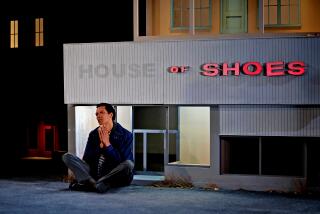THEATER REVIEW : âShirleyâ at Globe Canât Top the Film
SAN DIEGO â Shirley Valentine, tired of the same old routines, speaks of the excitement of not knowing what will happen next.
Yet many in her audience at the Old Globe Theatreâs Cassius Carter Centre Stage know exactly what will happen to Shirley. Willy Russellâs monologue about a working-class British womanâs great escape from diurnal drudgery was turned into a popular movie, starring Pauline Collins, who created the role onstage. Itâs likely that most of those who would be interested in Shirleyâs story already have seen the movie. If not, they can rent it for one-tenth or even one-twentieth the cost of a ticket at the Old Globe.
So the question arises: Is the play worth the extra expense? It would be myopic for the Old Globe to pretend that people wonât ask that, or to declare that questions of cost should have no bearing on our consideration of their âShirley.â After all, the relatively low production cost of a one-woman show probably had some bearing on their own decision to stage âShirley.â
Those who have seen only the movie may be surprised to learn that âShirleyâ is a monologue. In the movie, the subsidiary characters were sketched with remarkable precision by other actors. At the Old Globe, we hear many of their lines, but theyâre spoken not just through the filter of Shirleyâs perceptions, but in her actual voice, as Shirley recounts their end of her conversations with them. In other words, actress Katherine McGrath doesnât portray a variety of characters--as Lily Tomlin, for example, does in her own one-woman shows. McGrath plays no one but Shirley.
It requires a zealous faith in the power of the solo performer to believe that this is an advantage. This kind of faith is especially necessary when the solo performance is done in an arena staging, as it is here.
During long passages of this âShirley,â you look at the back of McGrathâs head, while the spectators on the opposite side of the room get to see her face. You canât watch the other charactersâ reactions; there are none.
Itâs not that McGrath and director Craig Noel havenât tried to accommodate the entire audience. Shirley is frequently on the move, shifting the angle of her address as much as possible. Before intermission, sheâs making dinner, and her moves from one room to another of Nick Reidâs spacious household set make sense. She talks not just to one wall, but to all of them--and the imaginary walls are located right where the audience sits.
After intermission, sheâs sunning on a rocky Greek beach, and the constant movement seems more artificial. The conceit in the script is that now sheâs talking to one of the rocks, yet that rock is in center stage. So the conceit is largely disregarded. McGrath directs her words out toward the audience, not at the rock.
There are more of those words in the play than there were in the movie. Shirley is more of a chatterbox here, and some of the lines that got left out of the movie are funny or charming little fillips. Others, however, seem superfluous or repetitive.
The play establishes one pertinent fact about Shirley that wasnât mentioned in the movie: She works outside the home. She refers to feeding the dog at âthe place where I work,â indicating that she probably does some form of domestic work. In the movie, we see the dog-feeding episode, but it takes place at a neighborâs house. The idea that Shirley has to work in someone elseâs home, then is faced with her own housework, makes her routines sound less bearable. But itâs not developed beyond that one reference.
Also, her son is more of a problem here. Near the end, we hear that he has been arrested. In the movie, heâs a sweet guy who actively prods his father into attempting a reconciliation with Shirley. Itâs another reason why Shirleyâs life in England sounds even less inviting in the play.
McGrath clearly establishes a different look for this Shirley. With curly red hair, high cheekbones and an otherwise angular face, sheâs a far cry from the pretty but pudgy Collins. There is no suggestion here that Shirley eats too much as compensation for her daily frustrations. Also, on a cosmetic level, itâs hard to discern why she makes such a distinction between her pre-Greek pallor and her subsequent tan.
Nevertheless, McGrath appears to know Shirley well. Her accent sounds flawless to these untutored ears. She measures Shirleyâs alternating degrees of depression and self-confidence with a fine hand, and she enthusiastically throws herself into Shirleyâs imitations of others.
âShirley Valentineâ
Katherine McGrath: Shirley Valentine
An Old Globe Theatre production. By Willy Russell. Directed by Craig Noel. Sets by Nick Reid. Costumes by Robert Wojewodski. Lights by Barth Ballard. Sound by Jeff Ladman. Stage manager Jerome J. Sheehan.
More to Read
Only good movies
Get the Indie Focus newsletter, Mark Olsen's weekly guide to the world of cinema.
You may occasionally receive promotional content from the Los Angeles Times.










